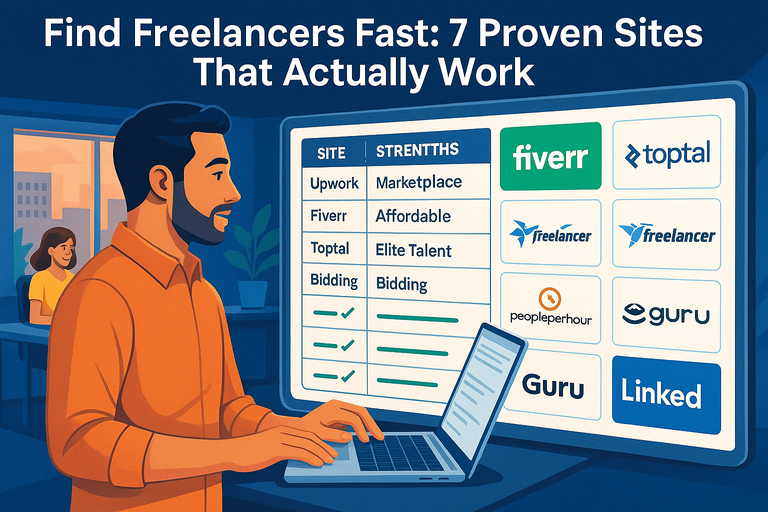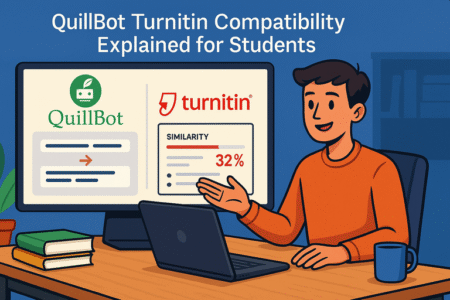Table of Contents
Find freelancers quickly without wasting time on endless searches is something every business owner or project manager struggles with.
Whether you need a skilled writer, a reliable developer, or a creative designer, knowing where to look can save you stress and money. But which platforms actually deliver talent you can trust?
That’s exactly what this guide covers—seven proven sites that make finding the right freelancer easier and faster than you might think.
1. Upwork: A Global Marketplace For Every Skill
Upwork is one of the most recognized names when you’re trying to find freelancers. Whether you need a copywriter, developer, virtual assistant, or even a project manager, the platform has talent from almost every corner of the globe.
It’s versatile, but like any tool, the way you use it determines whether you get a great hire or a headache.
How Upwork Matches You With Skilled Freelancers
When you create a job post on Upwork, the platform uses algorithms to surface your listing to freelancers with relevant profiles. Think of it like a dating app, but for work. The more detailed your description, the better your “match.”
From my experience, there are two main ways Upwork connects you with freelancers:
- Direct Job Posts: You create a project listing, set your budget, and freelancers send you proposals.
- Talent Marketplace Search: You can actively browse profiles, filter by hourly rate, skill, or even location, and invite freelancers directly.
One underrated tool is Project Catalog, where freelancers pre-package services (similar to Fiverr gigs). It’s faster than posting a job because you can instantly buy a ready-made service like “Website Audit in 48 hours.”
The match quality depends heavily on how clear you are. If your job title says “Need a website,” you’ll attract a flood of random applicants.
But if you specify “Need a WordPress e-commerce site with WooCommerce, SEO setup, and payment integration,” the algorithm favors freelancers with exactly those skills.
Pros And Cons Of Hiring Freelancers On Upwork
Like any marketplace, Upwork has strengths and weaknesses.
Pros:
- Access to millions of freelancers across every possible niche.
- Payment protection with escrow—your money is safe until work is approved.
- Built-in work tracking tools (time tracker app) for hourly projects.
- Flexibility to scale: hire one-off help or long-term contractors.
Cons:
- Service fees: Upwork charges 5%–20% depending on contract size.
- Proposal overload: for popular jobs, you might get 50+ applications.
- Varying quality: not every freelancer is as skilled as their profile suggests.
- Time zones: hiring globally often means coordinating across odd hours.
A quick example: I once posted for a blog writer. Within 24 hours, I had 40+ proposals. Half didn’t even mention the niche. But buried in that pile was a writer who became my go-to content partner for six months. The trick was filtering carefully and not rushing.
Tips To Get The Best Results On Upwork
Getting great hires isn’t about luck—it’s about process. Here’s what I recommend:
- Write Specific Job Descriptions: Detail tools, deadlines, deliverables. The clearer you are, the better the matches.
- Use Screening Questions: Simple things like “What’s one WordPress plugin you always install and why?” can instantly separate pros from amateurs.
- Check Work History And Reviews: Don’t just glance at stars. Read detailed reviews for patterns (missed deadlines? great communication?).
- Start With A Small Paid Test: Before handing someone a $5,000 project, give them a $100 test task. It saves you big headaches.
- Communicate Inside Upwork: It protects you in disputes and keeps records organized.
If you use Upwork well, it’s not just a platform—it’s practically your extended HR department.
2. Fiverr: Affordable Talent For Quick Projects
Fiverr started with the idea of “$5 gigs,” but today it’s far more than cheap logo design. It’s become a global service marketplace where you can buy ready-made solutions for almost anything—video editing, voiceovers, SEO audits, you name it.
If Upwork feels like hiring through job ads, Fiverr feels like walking through a digital marketplace where services are on display.
What Makes Fiverr Ideal For Small Budgets
The main reason people love Fiverr is affordability. You can get things done without breaking the bank.
Here’s why it’s budget-friendly:
- Pre-set Packages: Freelancers offer tiered pricing (Basic, Standard, Premium), letting you choose exactly what you can afford.
- No Proposal Overload: Instead of sifting through 50 applications, you browse gigs and buy directly.
- Fast Turnarounds: Many gigs are designed for delivery within 24–72 hours.
I once needed a podcast intro jingle. On Fiverr, I found a seller offering “Custom 15-second intro music” for $30. Within two days, I had a polished jingle with three variations to choose from. That kind of speed and cost-efficiency is hard to beat.
How To Navigate Fiverr’s Gig-Based System
Unlike Upwork, Fiverr isn’t about posting jobs—it’s about shopping. Think Amazon, but for services.
Here’s how to get the most out of it:
- Search Smart: Use detailed keywords like “Shopify store speed optimization” instead of just “Shopify.”
- Filter By Seller Level: Fiverr ranks sellers as New, Level 1, Level 2, or Top Rated. Higher levels usually mean more reliability.
- Check Delivery Times And Revisions: Always look for how many revisions are included—cheap gigs with no revisions can backfire.
- Message Sellers Before Ordering: Even though it’s a click-to-buy system, I always message sellers to confirm details. This avoids mismatched expectations.
The gig page itself is packed with clues: look at the “About This Gig” description, samples, and buyer reviews. If the portfolio looks copy-pasted or generic, that’s a red flag.
Strategies To Avoid Low-Quality Work
Fiverr has gems, but it also has plenty of sellers who overpromise and underdeliver. Here’s how to sidestep the pitfalls:
- Look For Verified Portfolios: Many sellers upload real project screenshots. If everything looks like stock images, run.
- Prioritize Communication: Sellers who reply quickly and clearly usually deliver better results.
- Use Mid-Range Pricing: The $5 gigs are tempting but often unreliable. I’ve found the sweet spot is usually $50–$200, depending on the task.
- Start Small, Then Scale: Order a basic package first. If you’re happy, upgrade to bigger services.
- Check For Extra Services: Many sellers offer add-ons (like “extra fast delivery” or “source files”). Compare these to see true value.
The beauty of Fiverr is speed, but don’t let that tempt you into impulse buys. A 10-minute background check can save you days of frustration.
3. Toptal: Elite Freelancers For High-Level Projects
Toptal isn’t your average freelance platform. If Upwork and Fiverr are like bustling marketplaces, Toptal is more like a private club—you only get in if you meet their strict standards.
For clients, that means you’re not wading through hundreds of unqualified applications. You’re getting access to vetted, elite talent.
Why Toptal Screens Only The Top 3%
Toptal is known for its rigorous screening process. They claim only 3% of applicants make the cut, and from what I’ve seen, that feels accurate.
The process usually includes:
- Language and communication tests.
- Skill reviews specific to the freelancer’s expertise (coding challenges, design tasks, etc.).
- Live interviews with Toptal experts.
This ensures you’re not just hiring someone who says they’re a senior developer—they’ve already proven it. It’s why big companies like Airbnb and Shopify have used Toptal for mission-critical projects.
If you’ve ever been burned by freelancers who disappear mid-project, the appeal of this vetting system becomes obvious.
The Best Types Of Projects To Use Toptal For
Toptal shines for high-stakes projects where precision and expertise matter. From what I’ve noticed, it’s perfect for:
- Software Development: Complex builds like mobile apps, SaaS platforms, or financial software.
- UI/UX Design: When user experience can make or break your product.
- Finance And Consulting: Toptal even offers CFO-level experts for strategy and modeling.
I wouldn’t recommend Toptal for small tasks like editing a blog or designing a simple logo. You’re paying for elite talent, so it makes sense to reserve it for projects where mistakes are costly.
Imagine you’re building an AI-powered app for your startup—this is exactly the kind of project where Toptal’s talent pool can save you from months of trial and error.
How Pricing Works On Toptal
Here’s where many people pause—Toptal isn’t cheap. Rates vary, but expect something like this:
- Developers/Designers: $60–$150 per hour.
- Finance Experts/Consultants: Often higher, depending on seniority.
- Trial Period: You usually get a two-week risk-free trial. If you’re not satisfied, you don’t pay.
One thing I like: Toptal matches you with a freelancer quickly, sometimes within 48 hours. They do the legwork of sourcing, so you’re paying for efficiency as much as quality.
If budget isn’t your top concern and you want guaranteed expertise, Toptal is the platform you can lean on.
4. Freelancer.com: Competitive Bidding For Your Jobs
Freelancer.com is one of the oldest players in the freelance space, and it thrives on its competitive bidding system.
Post a project, and you’ll often see dozens of proposals within hours. It’s a little chaotic, but if handled right, it can save you money and time.
How The Bidding System Saves You Time And Money
The beauty of Freelancer.com lies in the auction-like model. You post a job, set a budget, and freelancers bid against each other to win it.
Here’s why that works in your favor:
- Cost Savings: Bidding can drive prices down, especially for straightforward projects.
- Speed: I’ve had projects posted and awarded within the same day.
- Choice: You’ll see a wide range of bids—some lowball, some premium—giving you flexibility.
The trick is not to blindly choose the lowest bid. Often, the sweet spot is in the middle, where freelancers balance affordability with quality.
Common Challenges With Freelancer.com And How To Handle Them
Of course, the system has downsides. Let me break them down:
- Overwhelming Proposals: You can get 100+ bids for one job. Many are copy-paste pitches.
- Quality Variance: Some freelancers bid without real expertise just to get jobs.
- Fee Structure: The platform charges both clients and freelancers fees, which can be confusing.
My advice? Use filters to shortlist quickly. Focus on freelancers with strong reviews and verified portfolios. Don’t be afraid to disqualify generic proposals—you’ll save hours.
Proven Steps To Spot Reliable Talent On Freelancer.com
After trial and error, here’s what works for me:
- Check Milestone History: Reliable freelancers have a track record of completed milestones, not abandoned jobs.
- Use Skill Tests: Many freelancers showcase scores from platform tests. Use this as a credibility check.
- Interview Before Hiring: A quick 10-minute chat can tell you more than 50 reviews.
- Set Clear Milestones: Break the project into small deliverables. Pay after each one is approved.
- Start With Small Jobs: Test new freelancers on something minor before assigning bigger contracts.
Handled well, Freelancer.com is like a busy marketplace where, if you know how to haggle, you’ll find hidden gems.
5. PeoplePerHour: Flexible Hiring For Businesses
PeoplePerHour often flies under the radar compared to Upwork or Fiverr, but it’s a solid option—especially if you want flexibility between hourly and project-based work.
How PeoplePerHour Balances Hourly And Project Rates
One standout feature is the dual model. You can:
- Hire Hourly: Pay freelancers for tracked hours via the platform’s WorkStream system.
- Hire Per Project: Browse “Hourlies,” which are pre-set service packages (like Fiverr gigs).
This balance is perfect if you’re unsure whether you need ongoing support or just one-off help. For example, you might start with an “Hourly” for website maintenance, then shift into a fixed-price package for a redesign.
Unique Features That Set PeoplePerHour Apart
A few things make PeoplePerHour distinct:
- AI Matching: When you post a job, the platform uses AI to instantly match you with top freelancers.
- WorkStream Tool: This is their built-in project management chat + file system. Keeps communication tidy.
- Escrow Payments: Funds are held until you approve work, giving you peace of mind.
I once tested PeoplePerHour for a quick branding task. The AI instantly suggested three freelancers with portfolios that actually matched my brief—much faster than sifting manually.
Tips To Streamline Hiring On PeoplePerHour
If you want the platform to work for you, I suggest:
- Be Clear In Job Posts: State whether you’re open to hourly or fixed pricing. This helps filter applications.
- Leverage “Hourlies” For Speed: If you need something done in 24–48 hours, Hourlies are a lifesaver.
- Check Seller Ratings: PeoplePerHour uses a CERT score (Client Endorsements, Repeat Trust). The higher, the better.
- Use WorkStream For All Communication: It’s tempting to take chats off-platform, but keeping it inside helps in disputes.
- Start With A Trial Task: Just like with other platforms, test before committing big budgets.
PeoplePerHour might not have the name recognition of Upwork, but its flexibility and AI matching make it a strong choice, especially for small-to-medium businesses.
6. Guru: A Platform Built For Long-Term Collaboration
Guru doesn’t always get as much buzz as platforms like Upwork or Fiverr, but it quietly serves a big purpose: Creating long-term working relationships.
If you’re looking for a freelancer you can partner with for months (or even years), Guru is one of the best places to start.
Why Guru Works Well For Ongoing Projects
The platform was designed with continuity in mind. Unlike Fiverr, which is built around one-off gigs, Guru leans into retainer-style work and repeated collaborations.
Here’s why that matters:
- Profiles Show Long-Term Engagement: Many freelancers showcase years of experience with repeat clients.
- Job Posting Options: You can post ongoing contracts rather than just one-time tasks.
- Collaboration Tools: Features like the WorkRoom are built to keep teams working together smoothly over time.
I’ve noticed Guru is especially useful for businesses that need recurring help—think monthly content writing, bookkeeping, or software updates. Instead of starting from scratch with new freelancers every month, you can grow with the same person.
How The WorkRoom Tool Simplifies Communication
Guru’s WorkRoom is its secret weapon. Think of it as a mini project hub built into the platform. Inside each WorkRoom, you can:
- Assign tasks and milestones.
- Share files and documents directly.
- Keep all project discussions in one place.
- Track time for hourly contracts.
It feels more organized than relying solely on email threads. For example, I once had a designer updating my brand assets. Instead of juggling dozens of email attachments, we kept everything in the WorkRoom—logos, revisions, comments—so I never lost track of files.
If you’ve struggled with messy communication on other platforms, Guru’s setup feels refreshing.
Smart Ways To Manage Payments On Guru
Payments can make or break the freelancer-client relationship, and Guru has a good system for this. They use SafePay, which is basically their escrow tool. You fund a milestone, the freelancer works, and you release funds only when you’re satisfied.
To manage payments effectively, I suggest:
- Break Projects Into Milestones: This keeps cash flow steady and reduces risk.
- Use SafePay For Every Transaction: Even if you trust your freelancer, it keeps things transparent.
- Set Payment Terms Clearly: Agree upfront on hourly vs project-based billing to avoid surprises.
- Review Invoices Carefully: Guru lets freelancers create detailed invoices within the WorkRoom—take advantage of this.
With a bit of structure, Guru can feel less like a platform and more like a reliable partner in managing ongoing talent.
7. LinkedIn: Networking Your Way To Top Freelancers
LinkedIn isn’t a freelance marketplace in the traditional sense, but that’s exactly why it works so well. Instead of sifting through random profiles, you’re tapping into a professional network where people showcase their careers, not just gigs.
How To Use LinkedIn Search To Find Freelancers Fast
The search bar is your best friend here. If you type “freelance graphic designer” or “freelance content writer,” you’ll instantly see profiles optimized with those keywords. You can then filter results by location, industry, or even past companies.
A few pro moves:
- Use quotation marks for exact matches (“freelance copywriter”).
- Filter by “Open To Work” status—many freelancers actively mark themselves.
- Use LinkedIn ProFinder (in regions where it’s available) to get tailored matches.
I’ve personally found freelancers within minutes just by searching skill + “freelance.” It feels faster than waiting for applications on job boards.
Why Recommendations And Endorsements Add Trust
LinkedIn profiles aren’t just résumés—they come with social proof. Recommendations (long-form testimonials) and endorsements (quick skill votes) are gold when evaluating freelancers.
Here’s why:
- Recommendations often highlight soft skills like reliability and communication.
- Endorsements give a snapshot of which skills the freelancer is actually recognized for.
- Shared connections can provide direct referrals.
For example, I once found a freelancer through a mutual connection who had endorsed her for “SEO strategy.” That mutual link gave me enough trust to reach out immediately.
Steps To Write Effective Posts That Attract Freelancers
Sometimes the fastest way to find freelancers isn’t through search—it’s by posting on your own feed.
Here’s how to do it well:
- Be Specific In Your Post: Instead of “Looking for a designer,” write “I need a freelance UI/UX designer for a 3-month app redesign project. Experience with Figma required.”
- Include A Call To Action: Ask freelancers to comment or DM you with portfolios.
- Use Hashtags: Try #Freelance, #Hiring, #RemoteWork to boost visibility.
- Leverage Groups: Post in LinkedIn groups related to your industry for targeted reach.
I once posted a request for a freelance content editor and had five solid leads within 24 hours—all through my network.
Pro Tip: How To Choose The Best Platform For Your Needs
With so many platforms available, it’s easy to feel overwhelmed. The key is matching the right platform to your project type and budget.
Factors To Consider Before You Post Your First Job
Ask yourself:
- Do I need ongoing work or a one-time task?
- Is my budget tight, or am I willing to pay for top-tier expertise?
- Do I want to manage freelancers directly, or let a platform pre-vet talent for me?
These questions narrow down the field quickly.
Matching The Right Site To The Right Type Of Project
Here’s a quick cheat sheet:
- Fiverr: Small, fast, budget-friendly tasks.
- Upwork/Freelancer.com: Mid-range projects with flexibility.
- Toptal: High-end, complex builds where mistakes are expensive.
- Guru: Long-term collaborations with structured payments.
- PeoplePerHour: Good balance of hourly and project-based.
- LinkedIn: Great for tapping into professional networks.
Why Testing Multiple Platforms Pays Off
Don’t lock yourself into one platform immediately. I suggest experimenting. Try Fiverr for quick creative tasks, Upwork for a mid-sized project, and LinkedIn for niche expertise.
Over time, you’ll discover which platform consistently delivers the kind of freelancers you need.
Think of it as building your own talent ecosystem—different platforms for different types of work.






